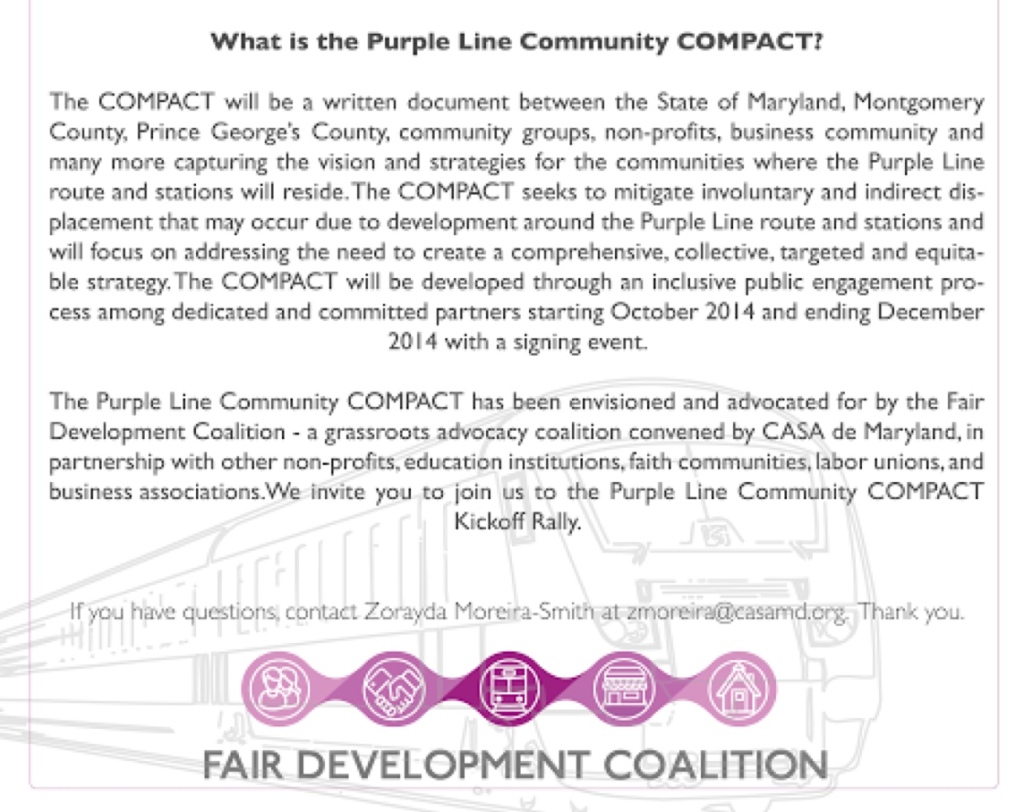The rally for a compact to promote fair development in relation to the Purple Line will occur on October 6th. What is the compact according to its promoters?
In essence, the key purposes of the compact are to prevent the displacement of affordable housing and small businesses currently located near Purple Line stops.
I look forward to seeing how they plan to square this circle.
Obviously, a central goal of the Purple Line is to improve transportation connections. And if people can more easily get from one place to another, the land around the stations should become more desirable and valuable, which will make it harder to afford to live and more expensive to operate a business near the stations as rents for housing and commercial space rise.
Indeed, proponents claim that the Purple Line will propel economic development around the stations. If successful, the spike in land prices will be far stronger than caused by faster transportation alone. It should also cycle in a positive way.
Think about places like Bethesda, Silver Spring, Ballston and Clarendon. As more businesses open and more people travel to the area, it becomes more desirable to locate businesses there. Similarly, more people will want to live near jobs and the commercial establishments in the area.
Just as improvements to the educational system or reductions in crimes make a place more attractive to open a business or establish a residence, ease of access both in terms of transportation and customers has the same effect.
Land prices will rise, as will rents for housing and businesses. Of course, the State and the County want this to happen. It’s not just a side effect but the point of spending $2.5 billion to build the Purple Line.
And hardly for nefarious reasons. As Montgomery County Councilmember George Leventhal has often explained correctly, economic growth generates jobs–not to mention the taxes that pay for services.
Local and state governments are always looking for ways to increase the tax base because the demand for services naturally exceeds the monies available. Moreover, if growth doesn’t occur, the demand for services rises even as funds dry up.
[And let’s avoid for now the political dynamite surrounding the benefits to the County’s budget balance–if not moral deficit–of attracting wealthy residents or displacing poorer ones to other jurisdictions. For our purposes, we’ll just assume that they stay in the County even if they have to move.]
In short, the proposed compact is likely to have success only to the extent that it tilts against the economic goals of the Purple Line. Some stations may attract much less growth than others–just compare the Metro stops in Prince George’s to those in Montgomery. In these areas, prices will rise comparatively less and they will remain more affordable.
Squaring the circle of displacement and growth seems all but impossible. If the County somehow prohibits or slows rents from rising on housing or businesses, it inhibits the growth of its tax base and undermines a central rationale for building the Purple Line.
To an extent, the inevitable concentration of growth around some stations but not others may provide some relief. But probably not in some areas that deeply concern Casa de Maryland like Langley Park, which is a natural prime target for redevelopment as middle-class residents get displaced from other more expensive areas.
It will not all be bad. Economically rising residents who have managed to acquire properties will benefit if they end up making a tidy profit if and when they decide to sell their land. Small businesses who have longer terms leases will see their customer base rise. And many will relocate successfully, though others will not.
And perhaps the proponents of the Compact have creative ideas to ease the collision of fundamental economic forces with real social needs that development around the Purple Line will not address.
If so, I look forward to hearing more about them. Engagement of an interested public and government on the problem may provide real benefits. But it’s not going to be easy.





